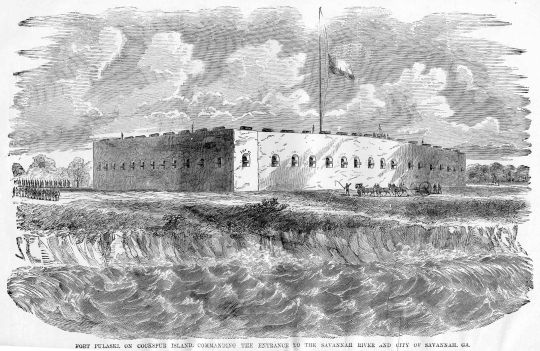
The latest war news from the April 16, 1862, issue of The Hudson North Star. This article will also be published in The Prescott Journal next week, on April 23, 1862. Now that spring was here, more was happening, on more fronts, than just the Battle of Shiloh.
The Battle of Fort Pulaski occured on April 10-11, 1862, although the Union advance on Fort Pulaski had began back on November 24, 1861. Tybee Island in Savannah’s harbor was thought to be too isolated and unprepared for conflict and was abandoned by the Confederates. This allowed Union troops to gain a foothold across the Savannah River from Fort Pulaski. In 1862, Fort Pulaski was considered invincible; its 7½-foot solid brick walls and massive reinforcing masonry piers. The Confederate garrison was under the command of Charles H. Olmstead,1 colonel of the 1st Georgia Volunteer Regiment.
After the surrender, Northern troops occupied the fort and commanded the entrance to Savannah, the principal port of Georgia, extending the Union blockade. The battle is also important for the innovative use of rifled artillery, which pounding of the fort’s stone walls essentially rendered stone fortifications obsolete.
For more details on the battle, see the National Park Service’s Fort Pulaski National Monument website.
T O – D A Y ‘ S N E W S .
_________________________
F o r t P u l a s k i C a p t u r e d !
A GALLANT ACHIEVEMENT !
BALTIMORE. April 15.—The Savannah Republican of the 12th announces the unconditional surrender of Fort Pulaski on the previous day. Seven large batteries of parrott guns at King’s Landing, and all the barbette guns on that side, and three casemate guns were dismounted.4
Colonel Olmstead,1 the rebel commander signaled the day previous to the surrender, that our fire was so terrible that no human being could stand upon the parapet for even a minute.

FORTRESS MONROE, April 14.—A flag of truce went to Craney Island this afternoon, and brought back two Norfolk papers. They were taken to headquarters and although containing the important information of the unconditional surrender of Fort Pulaski, an effort was made in accordance with the policy that prevails here to keep even good news from the representatives of the press. I am however, able to give you the substance of the glorious news as published in the Savannah Republican.
The Republican says substantially that it learns with deep regret that after a gallant defense against guns vastly superior that Fort Pulaski surrendered at two P.M. yesterday the 14th.
Corporal Law of the Pulaski Guards who did not leave Fort Thunderbolt until after the flag was hauled down brings the intelligence of the successful event.
The surrender was unconditional. Seven large breaches were made in the south wall by the federal battery of eight Parrott guns at King’s Landing.
All the barbette guns on that side were dismannered, and also three of the casemates, leaving but one gun bearing on that point. A clear breach was made in the magazine. The balls used were connical [sic], and were propelled with such force that they went clear through the walls at nearly every fire.
A Richmond paper contains an editorial exhibiting considerable fear for the safety of the city. It intimates that the Monitor, Naugatuck and Galena,6 all armed vessels might easily come up James river and by their invulnerability and powerful guns, take and keep possession of the city.
To prevent such a result it proposes that the channel of the James river shall be obstructed by stone, which it says is abundant for the purpose and should be used at once. The Merrimac has not come out and nothing has been seen of her to day. The tide had been low and this may have kept her in.
1. Charles H. Olmstead (1837-1926), was a Confederate Army officer and member of the 1st Georgia Infantry Regiment. On the morning of April 10, 1862, Union forces asked for the surrender of the Fort to prevent needless loss of life. Colonel Olmstead commander of the Confederate garrison rejected the offer. Reluctantly, Colonel Olmstead surrendered the fort on April 1x.
2. Quincy Adams Gillmore (1825-1888), a brilliant member of the U.S. Army’s Corps of Engineers, “is described by the newspaper correspondent Whitelaw Reid as ‘a quick-speaking, quick-moving, soldierly man . . . a fine, wholesome looking, solid six footer, with big head, broad, good humored face, and a high forehead faintly elongated by a suspicion of baldness, curly brown hair and beard, and a frank open face.’ His greatest attribute as a soldier was a fearless disregard for tradition. At the Battle of Fort Pulaski, Gillmore was breveted a brigadier and later he became a major general of volunteers.” (From Battle for Fort Pulaski on the National Park Service website for Fort Pulaski National Monument.)
3. Original Photographs Taken on the Battlefields During the Civil War of the United States, by Mathew B. Brady and Alexander Gardner, Hartford, Conn.: [Edward Bailey Eaton], 1907; available in the UWRF University Archives and Area Research Center (E 468.7 .E14 1907).
4. Barbette guns- protective amours feature around a cannon or heavy artillery gun; it protected the gun. Parrott gun- a muzzle loading rifled artillery that was made from cast iron for both strength and accuracy. Casemate- a fortified gun emplacement or armored structure from which guns are fired.
5. The Soldier in Our Civil War: A Pictorial History of the Conflict, 1861-1865, Illustrating the Valor of the Soldier as Displayed on the Battle-field: From Sketches drawn by Forbes, Waud, Taylor, Beard, Becker, Lovie, Schell, Crane, Davis and Numerous Other Eye-Witnesses to the Strife, edited by Paul F. Mottelay and T. Campbell-Copland; with an introduction by Robert B. Beathl, New York: Stanley Bradley Pub. Co., 1893; available in the UWRF University Archives and Area Research Center (E 468.7 .M68 1893).
6. All three of these ships were ironclads.
One thought on “1862 April 16th: Fort Pulaski Captured”